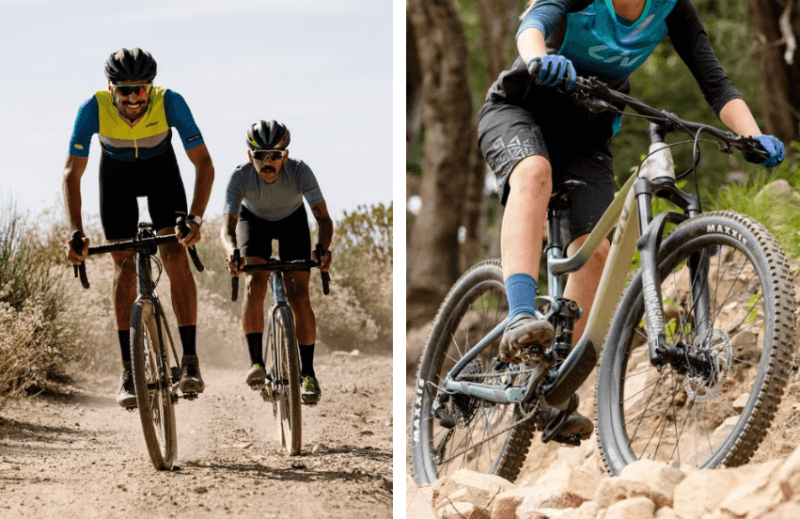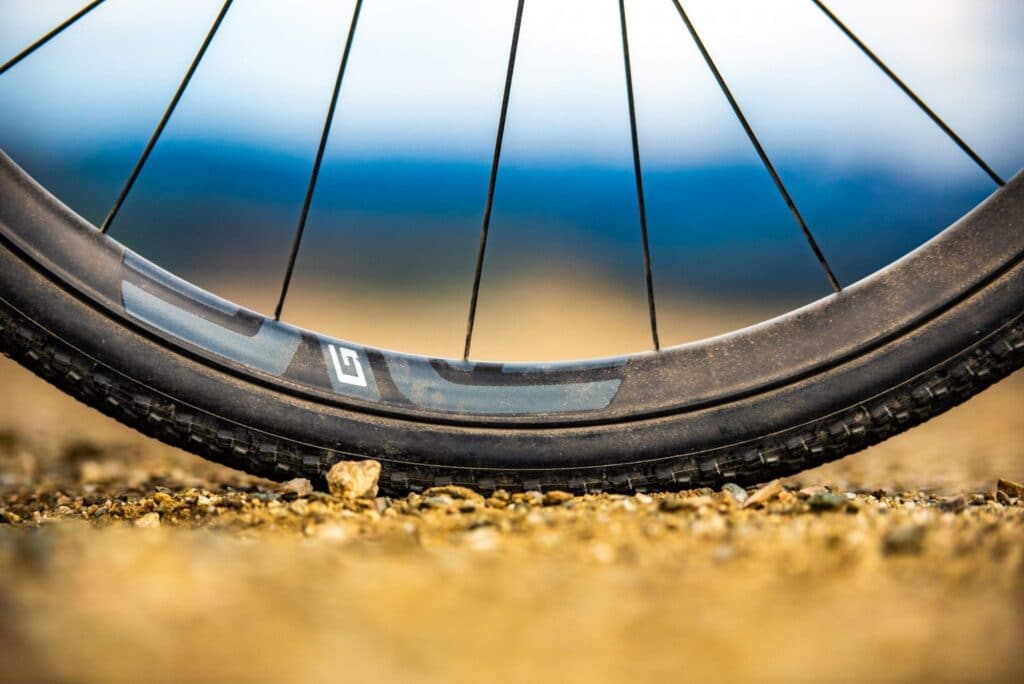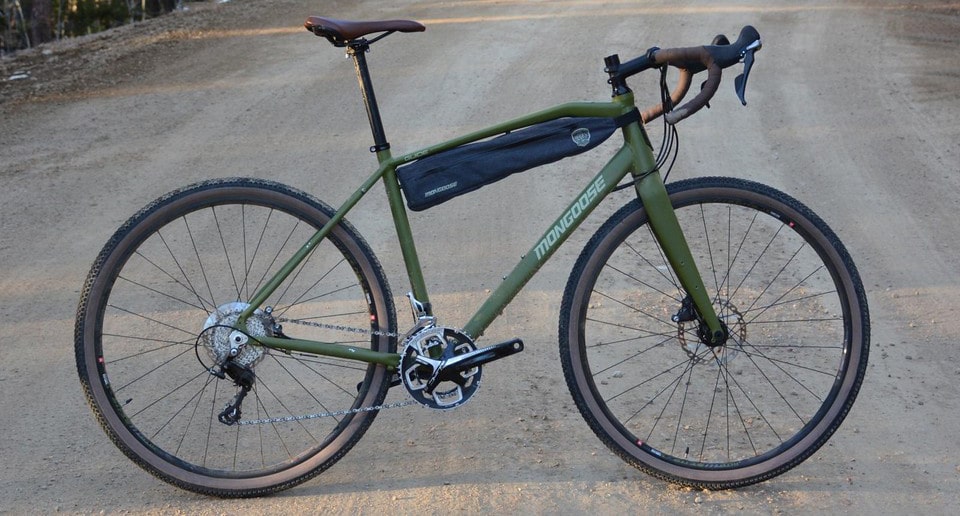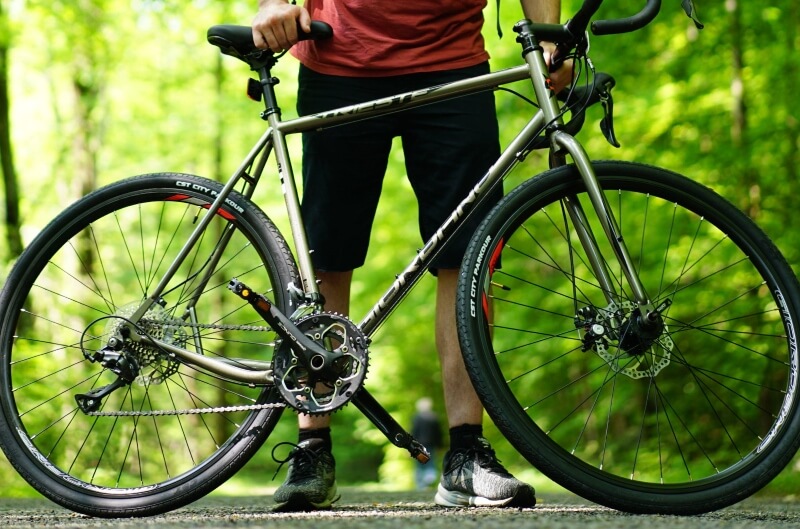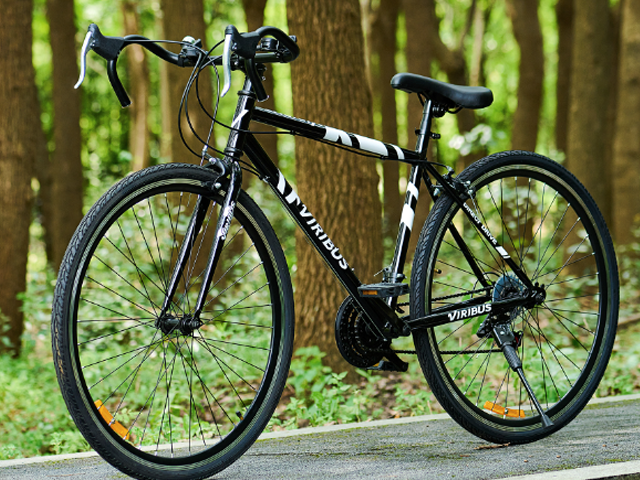- Trails
-
Bikes
-
Gear
-
Tips & Tricks
-
About us


Road bikes and gravel bikes look similar in frames, drop bars, and tires but they are different in their functionalities. We will look at the differences between gravel bike vs road bike and how that is reflected in their design, features and capabilities to optimize them for their respective terrains. Some of the features that vary between the two types of bikes are the frame, geometry, mounts, and tire clearance. We have broken down these features in our in-depth review of the two bikes. We also compare gravel bike vs road bike vs mountain bike to help you find the right bike for you. For instance, we consider gravel bikes a middle ground between mountain bikes and road bikes. Although gravel bikes do not have the advanced capabilities of mountain bikes and they are not as fast as road bikes, they allow users to enjoy a bit of both bikes to navigate versatile surfaces. Now, let’s take a closer look at the difference between road and gravel bikes.
A gravel bike is designed for off-road surfaces such as fire trails, gravel roads, byways, forest tracks, and dirt roads. It is designed as a road bike with additional features that equip it for multiple terrains.
These features include flared drop handlebars, lower gears, and more relaxed geometry as well as a heavier reinforced frame and wider tires for stability on rough surfaces.
Pros:
Cons:
A road bike is designed for tarmac riding. Road bikes come in two types; endurance bikes and race bikes.
Endurance bikes have relaxed frame angles for greater comfort and more stable handling over a long distance. They are also more upright and may include integrated mounts and storage. Endurance bikes are sometimes referred to as sportive bikes.
Race bikes include tube-like components that make them more aerodynamic in shape. They are also lighter with steeper angles and aggressive geometry to allow for quick riding.
If you look at the functions of road bikes vs gravel bikes, it is better to compare endurance bikes vs gravel bikes as the latter are more similar to endurance bikes than racing bikes.
Pros
Cons:
There is a difference in gravel vs road bike speed as well as in other features that we have discussed in the section below.
The first difference between a road bike and a gravel bike is the price. There are plenty of road bikes under $500 . Gravel bikes tend to be more expensive although you can find a budget model that costs less than $1,000. Apart from the type of bike, other factors that will influence the price of a bike are the frame construction, wheels, and other components. Steel and carbon fiber frames cost more than frames made of aluminum.
A Cyclocross bike Trusted Source Ipswich hosts international field for cyclo-cross championships Hundreds of riders are vying to be world champion in their age group in Suffolk this weekend as they take part in the UCI 2021 World Masters Cyclo-Cross Championships. How is the two days of racing going? www.bbc.com tire has knobs for extra grip during races. Similarly, the tire size and texture of gravel bike vs road bike vs mountain bike varies because these are different types of bikes designed for different surfaces.
Road bikes typically have 28 mm tires, and endurance bike tires can be as wide as 35 mm. The tires have a smoother pattern, and endurance bikes have wider tires than racing bikes. Road bikes support 700c wheels, and 650b or 650c for smaller models.
Gravel wheels are wider, typically measuring 33mm to 40 mm, and they could be as wide as 50 mm which is the width of an XC mountain bike tire. The tires have a tread pattern and knobs for comfort as well as additional grip and traction for off-road riding. Gravel bikes support 650b or 700c wheels. You can choose from a variety of tread patterns designed for different terrains and weather conditions. For instance, tires with rougher patterns and side lugs will be more suitable for muddy trails whereas a diamond tread will be ideal for dry surfaces.
Wider tires such as the 700x40c tires of Tommaso Sterrata Shimano Claris R2000 improve grip by allowing for low pressure.
Both road tires and gravel tires are available in a tubeless design to lower the pressure without an inner tube that can get trapped between the rim and tire. Technology is more common in gravel bikes.
As for the gravel frame vs road frame, there is little difference between gravel bike and road bike frame construction materials. Both types typically utilize carbon or aluminum, with titanium and steel being the preferred material for niche bikes. The type and grade of frame material will determine the bike’s weight, pricing, durability, and level of absorption.
The Carbon is lightweight and great at dampening vibrations. You can also easily adjust its stiffness to craft a tube-shaped aerodynamic frame.
Aluminum is also lightweight and a popular choice for entry-level bikes because it is durable and affordable.
Titanium is lightweight and provides a superior riding experience. It is often featured in premium bikes.
Steel is mostly used for gravel bike frames because it is robust and durable with high vibration absorption capacity. It is the go-to option, especially for custom gravel bikes.
The difference between gravel bike and road bike geometry may not be immediately obvious because they might differ by only a few millimeters. However, the geometry of a bike is important because it will determine how well it fits and how comfortable it feels.
Geometry includes the seat tube length expressed in centimeters as well as the wheelbase, head length, and chainstay length. It may also include reach and stack measurements. Manufacturers usually include this information so buyers can compare bikes and choose the ideal size and frame shape for their needs.
Road bikes typically come with a shorter head tube and frame stack and a longer reach to provide a longer and lower aerodynamic design whereas gravel bikes tend to be more upright with a shorter reach, higher stack and a longer head tube that improves comfort and allows you to shift your body weight when navigating descents and other obstacles.
Road bikes also have steeper head tube angles and a short wheelbase for quick and precise riding, compared to the slacker head tube angles and longer wheelbase of gravel bikes that enhance stability.
When comparing gravel bike geometry vs road bike geometry, you must factor in the intended purpose. For instance, gravel vs road bike speed differs and the design of a specific bike will reflect that in its geometry. The geometry of a gravel bike is lower, longer, and slacker to maximize comfort, capability, and stability while a road bike’s geometry gears more towards optimizing speed and responsiveness. We see this in Trinx TEMPO1.0 700C which has been rated highly for being fast and responsive without the high cost of comparable models.
Gravel bikes may have flattened and curved parts in the rear triangle to improve comfort and dampening of vibrations.
You will find some gravel bikes with a seat post that is more exposed and a sloping top tube instead of a straight top tube to make a compact and lighter frame that improves maneuverability.
Another difference between gravel bikes and road bikes is in their pedal styles. Pedals for gravel bikes are suited for off-road rugged terrains and they feature dual-sided SPD 2-bolt pedals and metal cleats that are often used for mountain bikes. SPD refers to Shimano Pedaling Dynamics. There are also gravel bikes with flat pedals or trail pedals.
Road bikes incorporate SPD-SL 3-bolt pedals because they are efficient. SL refers to SuperLight. These lightweight pedals work best with cycling shoes that have a stiffer sole.
The next factor you should keep in mind when deciding between a road bike or a gravel bike is suspension. When discussing suspension in gravel bike vs road bike vs mountain bike, mountain bikes win because the suspension is almost synonymous with mountain bikes.
Road and gravel bikes are also available with various kinds of suspension. The maximum tire width a bike supports is determined by the tire clearance between the forks, chainstay, and seatstay.
For gravel bikes, the tire clearance is wider to accommodate a broad range of tires and treads and to navigate through wet and muddy conditions. Some users may prefer 650b wheels on gravel bikes with limited clearance to fit larger tires without switching the frame.
There are also gravel bikes with integrated frame micro-suspension favored for road bikes such as endurance bikes.
Suspension helps to improve the comfort and efficiency of a bike by allowing the wheels to move independently. However, suspension forks and rear shocks are not required in a road bike because they would have a negative impact on its weight and performance.
Having said that, Specialized does incorporate a damped coil shock system that is close to a suspension fork for racing bikes. The Future Shock System is featured in Roubaix and Diverge models to promote efficiency.
The cockpit is a collective name for pedals, saddle, and handlebars.
Road bikes come with narrow handlebars with deeper drops and a longer reach that is suitable for paved roads. Racing road bikes feature handlebars and seat posts with an aerodynamic shape to reduce air drag for optimal efficiency.
Gravel bikes feature a shorter reach and wider handlebars with flared drops that allow easy access to the brake levers and enough clearance for wrists to grant you more control and increase stability when riding through tight corners and other obstacles. Some models have flat handlebars.
Premium gravel bikes may also include dropper posts that allow you to raise or lower the saddle with a lever when navigating rough terrains and steep descents.
The seat post diameter of a bike generally ranges from 27.2 mm to 31.6 mm. A smaller seat post is more comfortable while a larger one is better at strength and stiffness.
In addition to dropper posts, advanced bikes may also have or support suspension seat posts and stems.
Both road bikes and gravel bikes require proper maintenance to optimize their performance and extend their lifespan Trusted Source Teen who climbed Bear Mountain on Citi Bike was gifted used bike Filmmaker gives old bike to teen who climbed Bear Mountain on Citi Bike nypost.com . Gravel bikes may take a bit more effort to maintain due to their designated terrains. They are more prone to punctures and gathering mud, snow and debris on off-road surfaces, compared to road bikes which you ride on paved roads.
There is a difference between gravel bike and road bike components although most are compatible with the other. For instance, gravel bikes come with disc brakes for greater power and control while rim brakes are better suited for road bikes.
Road bikes also have 2x drivetrains and two front chain rings whereas gravel bikes feature 1x or 2x drivetrains and one front chain ring.
Besides that, gravel bikes come with a rear derailleur that has a clutch to prevent the chain from slapping or dropping on bumpy terrains.
The finishing kit consists of saddles, stems, seat posts, and handlebars. You will notice the differences in these features between road bike vs gravel bike because the two bikes serve different purposes.
The former, specifically racing road bikes, has seat posts and handlebars with an aerodynamic shape for speed and efficiency. The latter has flared handlebars to increase stability and maneuverability on rough terrains and seats that are more comfortable for long rides on bumpy trails.
Road bikes are lighter with an aerodynamic shape and other features that promote speed, efficiency, and precision on paved roads. Gravel bikes are sturdier with wider wheels for superior comfort and stability during off-road riding.
The following questions and answers will shed more light on the difference between gravel bikes and road bikes and where they perform best.
Yes, you can use a gravel bike as a road bike but bear in mind that gravel vs road bike speed is not the same. You are likely to find a grave bike slower, heavier, and less responsive if you intend to use it as a racing bike. A good alternative would be an all-road bike that blends the features of a gravel bike and a road bike.
Road bikes usually support one set of 650b, 650c, and 700c wheels. Comparatively, gravel bikes are more versatile because they can support two sets of wheels; 700 cc, and 650b wheels that let you use a smaller wheel with a wide tire.
Yes, of course. It is one of the surfaces where a gravel bike trumps other bikes. Gravel bikes have generous mud clearance, reinforced frames, slacker angles, a longer reach, and wider tread-patterned wheels that are stable and great at providing superior traction and absorbing vibrations.
An all-road bike blends the features of a gravel bike and a road bike. A gravel bike is more aimed at difficult terrains, this is why they are perfect for off-road riding, but if you want to experiment with speeds, an all-road bike is your best choice.
Choosing the best bike to buy can be intimidating when you don’t know what to look for because the market is full of multiple models with different features and capabilities. We have explained the difference between gravel bikes and road bikes and how it impacts their cost, performance, and designated terrains. The cost of bikes varies from one type and model to another but the construction material of the frame and the wheel size are some of the factors that may affect the pricing of gravel bikes vs road bikes.
